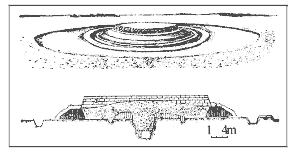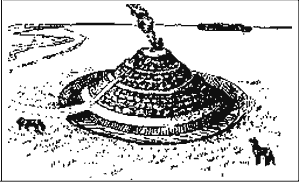Back
In Russian
Back to Archeology
N. Pontic Scythians 7 c. BC
From Huns to Bulgars 6 to 15-th c. AD
Òþðêñêèé and European Genetic distance
Kurgan Afanasiev Culture 2,500 -1,500 BC
Kurgan Andronov Culture 1,500 - 1,000 BC
Kurgan Karasük Culture 1,000 BC - 500 BC
About Kurgans
Avar Dateline
Besenyo Dateline
Bulgar Dateline
Huns Dateline
Kimak Dateline
Kipchak Dateline
Kyrgyz Dateline
Sabir Dateline
ABOUT KURGANS
Ludmila Koryakova
Notes About Material Culture of Eurasian Nomads
Ekaterinburg, Russia 2000
Links
Citations from the work
Quite frequently the nomads used pottery produced by sedentary populations; for instance the Sarmatians of the Don and Itil areas are known to have some of that pottery. During the 8th-7th centuries BC, the nomads in that region had only temporary camps in the open steppes, although they also had stable settlements in the forest-steppe. Very often the latter were defended by fortifications, and frequently the forest served as a place of refuge.
The complexes of the Andronovo and Timber-Grave Kurgan Cultures produce evidence of a more complicated economic structure than the mere nomadic which existed in the Eurasian steppes. During the second half of the second millennium BC (i.e. 1500-1000 BC), the economy, as seen form the archaeological materials, was not culturally homogeneous, although it appeared to have been quite similar over a huge geographical region.
Nomadic material culture is characterized by specifics recognizable as ethnographic models. In terms of economic and cultural types existed certain levels or degrees of nomadism: vagrant, semi-settled, semi-nomadic, and nomadic. All of these types of nomadism are known historically; yet, if we observe them from a material culture point of view, we would not notice any significant differences between them.
If we have remains of large settlements consisting of dozens of large houses, as is the case with the Andronovo Culture, how can be determined the nomadic character of that culture? To what extent can we evaluate certain key distinctions in production, mobility, and settlement in the prehistoric pastoral and agro-pastoral cultures. The nomadic pastoralism consists of pastoralism and nomadism. The greater a degree of pastoralism, the stronger is a tendency toward nomadism.
The "Ancient Nomads" pastoralists of the Eurasian steppe had a kurgan funeral ritual. The Scythians, Sarmatians, and other ancient nomads had huge kurgans containing remains of large wooden (sometimes stone) funerary chambers. Obviously, the erection of such structures required a large investment of labor, and a use of a lot of wood, a commodity usually not easily accessible in the treeless steppes. Such structures were taken as evidence of social stratification. But some of the famous Scythian funeral complexes appear to have been repeatedly reused and could be place of permanent dwelling of the nomadic people. In the Pazyryk Culture was observed that some logs from permanent living quarters were reused in the construction of the funerary chamber. An upper covering placed above the funeral room in Kurgan 1 of the Ak-Alakha Cemetery, for example, comprised logs from a demolished polygonal house. This indicates that nomads had quite sturdy winter houses in the locales with severe weather. The Ukok Plateau was treeless, but the Pazyryk people used a large amount of wood in their funerary constructions. They could have transported it from the nearest forest during winter by pulling it on the ice, as is being done in recent times. A dendrochronological analysis has shown that all of the logs used for funerary chambers were felled during the winter. These observations indicate that the most sophisticated funerary structures could have been built in advance, possible in stable ecological and political conditions.
A kurgan was not only a functional mortuary construction, it also was a complex architectural structure which reflected artistic or cosmological ideas existing within the society. A typological variety of inner kurgan constructions exist in the vast steppe and forest-steppe zone. The large kurgans of the Iron Age Eurasian kurgans usually occupied a highest point in the landscape, visibly connected to other large kurgans forming a chain that can stretch for 5-10 kilometers. Within these complexes are also included smaller kurgans. The kurgans were landmarks in the nomadic communication system. The single kurgan burials, generally located in the watersheds, situated in the open steppes some significant distance from the river, appear only at the beginning of the Iron Age ( i.e. ca. 1000 BC). They differed from the kurgans of the Bronze Age usually located in groups along river terraces.
A research of the construction of the kurgan structures was done by several groups of archaeologists, particularly in the northern Kazakhstan, and in the southern Urals. In the northern Kazakhstan a detailed paleosoil analyses permitted scholars to conclude that large kurgans, such as Kara-Oba and Obaly in northern Kazakhstan, were built from rectangular blocks of topsoil in the form of bricks. Researchers reconstructed building sequence of a kurgan in the following manner:
"Initially was selected a place suitable for a burial. It had to be situated near a pasture, not far from a water source, and certainly on the elevated and forestless steppe terrain. The place for the burial kurgan was outlined by a shallow, wide ditch, a soil from which was placed on the inner side of the ditch. Then-were performed ceremonies,-the traces of which are in the changed character of the paleosoil and remains of the organic materials, such as grass or brushwood. After that was dug a grave pit. A large amount of the soil taken from the pit was spread around it, and a smaller amount was spread further out within a defined area. A circular moat of a smaller diameter than that of the ditch was erected from the loamy humus soil. The burial had bneen completed, and a part of the soil was returned to the pit. The surface of the pit was covered with brushwood and filled with soil. The top level of the structure was covered with topsoil blocks. And finally, the structure was plastered with clay extracted from the ditch" (Zdanovich et al 1984: 43-44).
The average quantity of soil removed from the surface inside the concentric area was approximately 2100 sq m. According to calculations, the labor necessary only for the construction of the kurgan required 200-400 individuals for 10 days, or 70-140 individuals for one month. If we add the labor necessary to complete the funerary chamber (woodcutting, transportation, etc.), digging the ditch, and the other operations, it is apparent that the erection of such a large kurgan would have been very laborious. The Kara Oba kurgan was in the form of a truncated stepped cone, with a height of 4 m (Fig. 1). Calculations for the Varna Kurgan, located in the southern Urals, and results of its experimental reconstruction, indicated that that circular three-tiered structure had a height of 5.7 m and an upper diameter of 1.6 m (Fig. 2). These two examples allow us to understand a grandiose impression these structures made.
Fig. 1. Kara-Oba kurgan, northern Kazakhstan. Reconstruction of the surface construction
(After Zdanovich, et.al., 1984,
plate 4.)

Fig. 2. Varna (South Urals). A variant of the reconstruction
(After Tairov and Botalov 1988, plate 7.)

Kurgans are also considered to be markers for the territorial boundaries of a clan or a family lands. Until recent times, the Kazaks and Kyrgyz buried their deceased only near the winter pastures. According to Dyakonova's data, the Tuvinians buried their deceased in the areas of traditional transmigration. Therefore, the members of a clan could be buried in different cemeteries (those of winter or summer) within the clan territory. We should be able to identify the cemeteries that belong to a specific clan. Archaeologically, they would have been considered as separate units within one or another archaeological culture, while they are specific social groups not only culturally, but also as a component of the social landscape.
Ethnographers and archaeologists consider horse harness accouterments to be a prime marker of the nomadic mode of life: horse bits in the graves and special horse burials are widely spread throughout the nomadic territory from the Iron Age ( i.e. ca. 1000 BC) to the Medieval period ( i.e. ca. 1500 AD). In the Sargat Culture, for example, one out of every two graves yielded remains of a horse harness. The horse harness is one of the typical chronological indicators of a nomadic culture. In contrast, during the Bronze Age ( i.e. ca. 2000-1000 BC) the frequency of any object associated with horse transport was quite limited. The wagons and chariots, and bone cheek pieces were, however, characteristic for some Eurasian steppe cultures of the Middle Bronze Age ( i.e. ca. 1500 ± 200 BC).
Additional Literature
Back
In Russian
Gorny Altai Population 1-2 Millenium BC (Pazyryk)
N. Pontic Scythians 7 c. BC
From Huns to Bulgars 6 to 15-th c. AD
Òþðêñêèé and European Genetic distance
Kurgan Andronov Culture 1,500 - 1,000 BC
Kurgan Karasük Culture 1,000 BC - 500 BC
Alan
Dateline
Avar
Dateline
Besenyo Dateline
Bulgar Dateline
Huns Dateline
Karluk Dateline
Kipchak Dateline
Sabir
Dateline